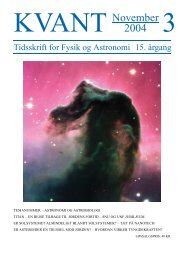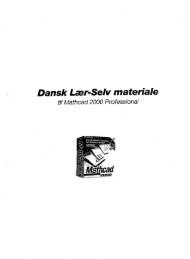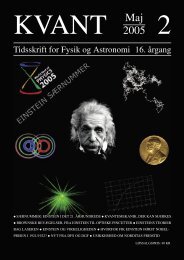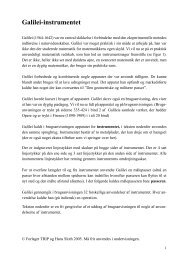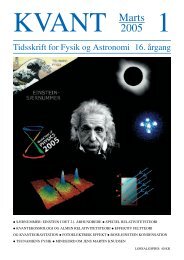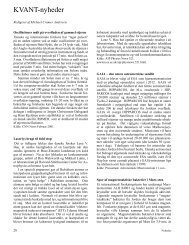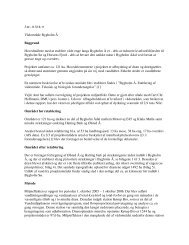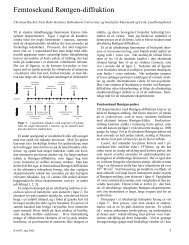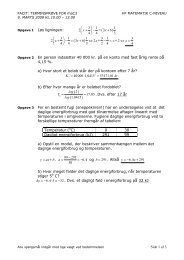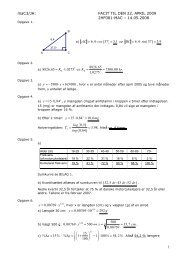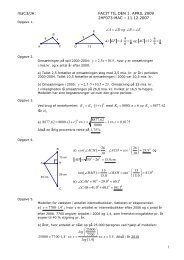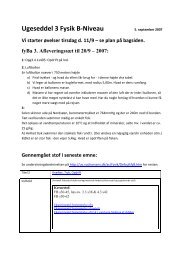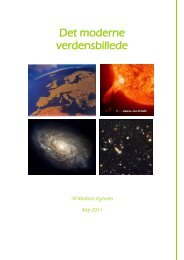Chapter 7 The Outer Planets
Chapter 7 The Outer Planets
Chapter 7 The Outer Planets
Create successful ePaper yourself
Turn your PDF publications into a flip-book with our unique Google optimized e-Paper software.
206 <strong>Chapter</strong> 7 <strong>The</strong> <strong>Outer</strong> <strong>Planets</strong><br />
actually consists of hundreds upon hundreds of closely<br />
spaced thin bands, or ringlets, of particles (Figure 7-22b).<br />
Furthermore, myriad dust-sized particles fill the Cassini and<br />
Encke divisions.<br />
<strong>The</strong> Voyager cameras also sent back the first high-quality<br />
pictures of the F ring, a thin set of ringlets just beyond<br />
the outer edge of the A ring. Two tiny satellites following<br />
orbits on either side of the F ring serve to keep the ring intact<br />
(Figure 7-23). <strong>The</strong> outer of the two satellites orbits Saturn at<br />
a slower speed than do the ice particles in the ring. As the<br />
ring particles pass near it, they receive a tiny, backward<br />
gravitational tug, which slows them down, causing them to<br />
fall into orbits a bit closer to Saturn. Meanwhile, the inner<br />
satellite orbits the planet faster than the F ring particles. Its<br />
gravitational force pulls them forward and nudges the particles<br />
into a higher orbit. <strong>The</strong> combined effect of these two<br />
satellites is to focus the icy particles into a well-defined, narrow<br />
band about 100 km wide.<br />
Because of their confining influence, these two moons,<br />
Prometheus and Pandora, are called shepherd satellites or<br />
shepherd moons. Among the most curious features of the<br />
F ring is that the ringlets are sometimes braided (Figure 7-24)<br />
and sometimes separate.<br />
Saturn’s shell of liquid metallic hydrogen produces a<br />
planetwide magnetic field that apparently affects its rings.<br />
Saturn’s slower rotation and much smaller volume of liquid<br />
metallic hydrogen produce a surface magnetic field only<br />
about 2 /3 as strong as Earth’s surface field. Data from spacecraft<br />
show that Saturn’s magnetosphere contains radiation<br />
Prometheus<br />
Pandora<br />
F ring<br />
A ring<br />
Encke<br />
division<br />
FIGURE 7-23 <strong>The</strong> F Ring and Its Two Shepherds Two tiny<br />
satellites, Prometheus and Pandora, each measuring about 50 km<br />
across, orbit Saturn on either side of the F ring. <strong>The</strong> gravitational<br />
effects of these two shepherd satellites confine the particles in the<br />
F ring to a band about 100 km wide. (NASA)<br />
belts similar to those of Earth. Furthermore, dark spokes<br />
move around Saturn’s rings (Figure 7-25); these are believed<br />
to be created by the magnetic field, which lifts charged particles<br />
out of the plane in which the rings orbit. Spreading the<br />
particles out decreases the light scattered from them and<br />
therefore makes the rings appear darker.<br />
FIGURE 7-24 Braided F Ring This photograph from Voyager 1 FIGURE 7-25<br />
Spokes in Saturn’s Rings Believed to be caused by<br />
shows several strands, each measuring roughly 10 km across, that<br />
Saturn’s magnetic field temporarily lifting particles out of the ring plane,<br />
comprise the F ring. <strong>The</strong> total width of the F ring is about 100 km.<br />
these dark regions move around the rings like the spokes on a rotating<br />
(NASA)<br />
wheel. (NASA)




